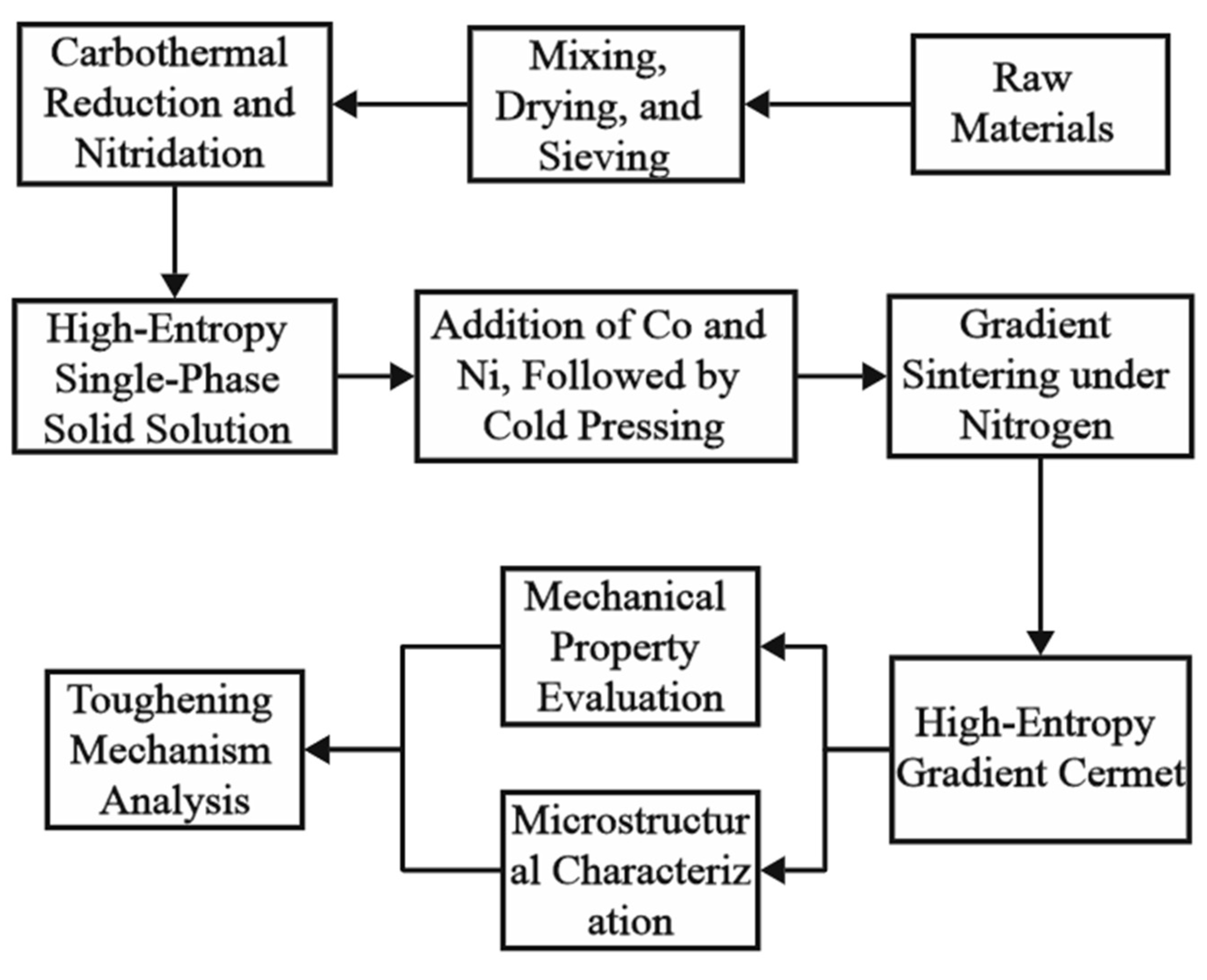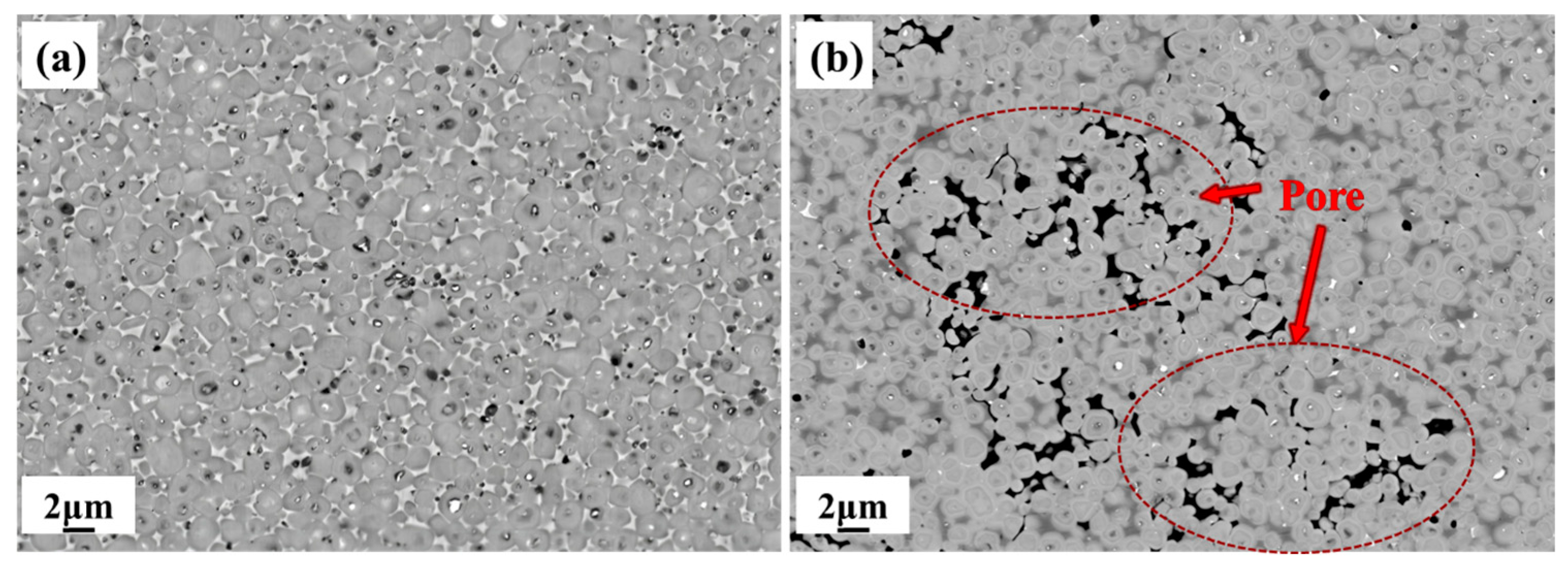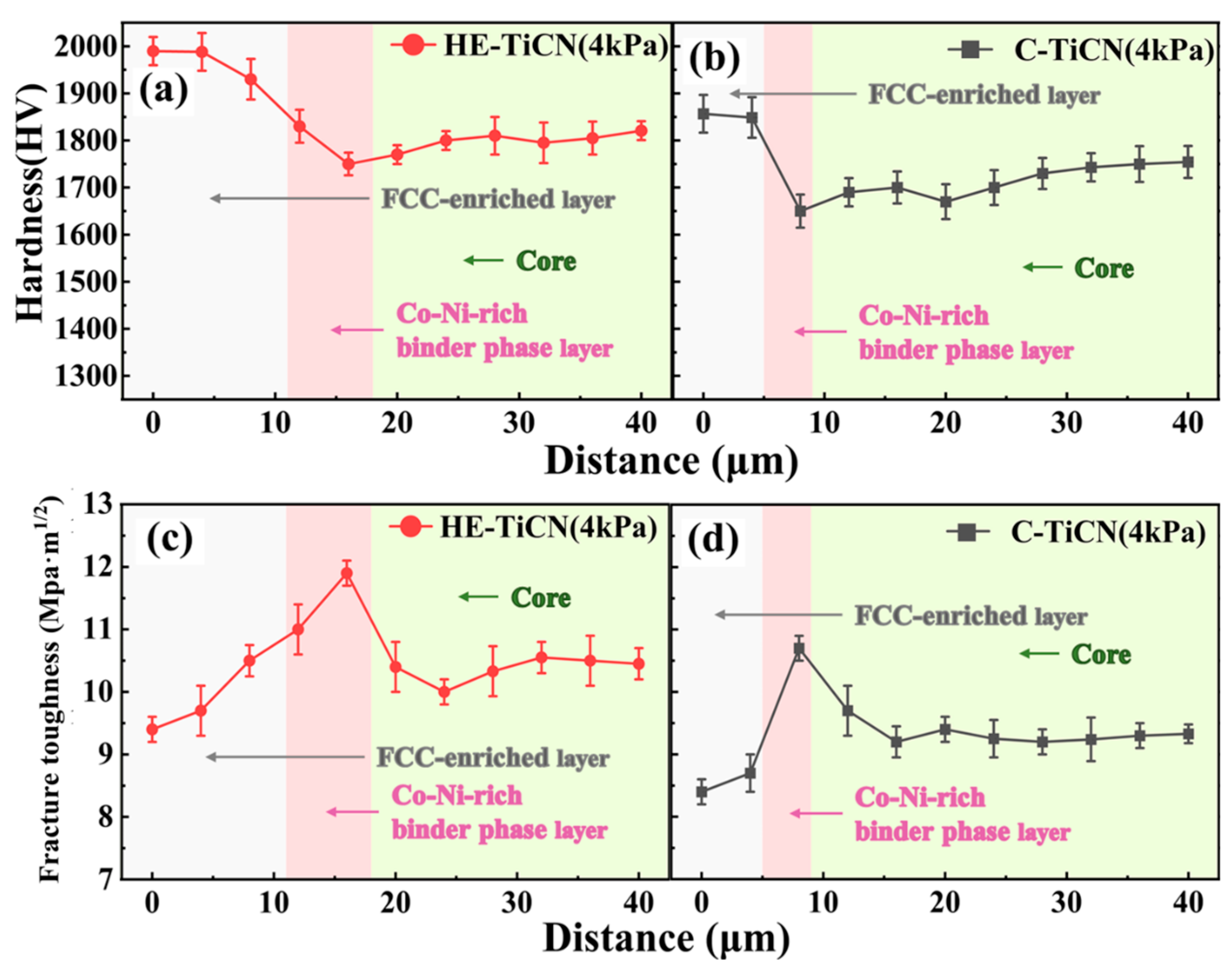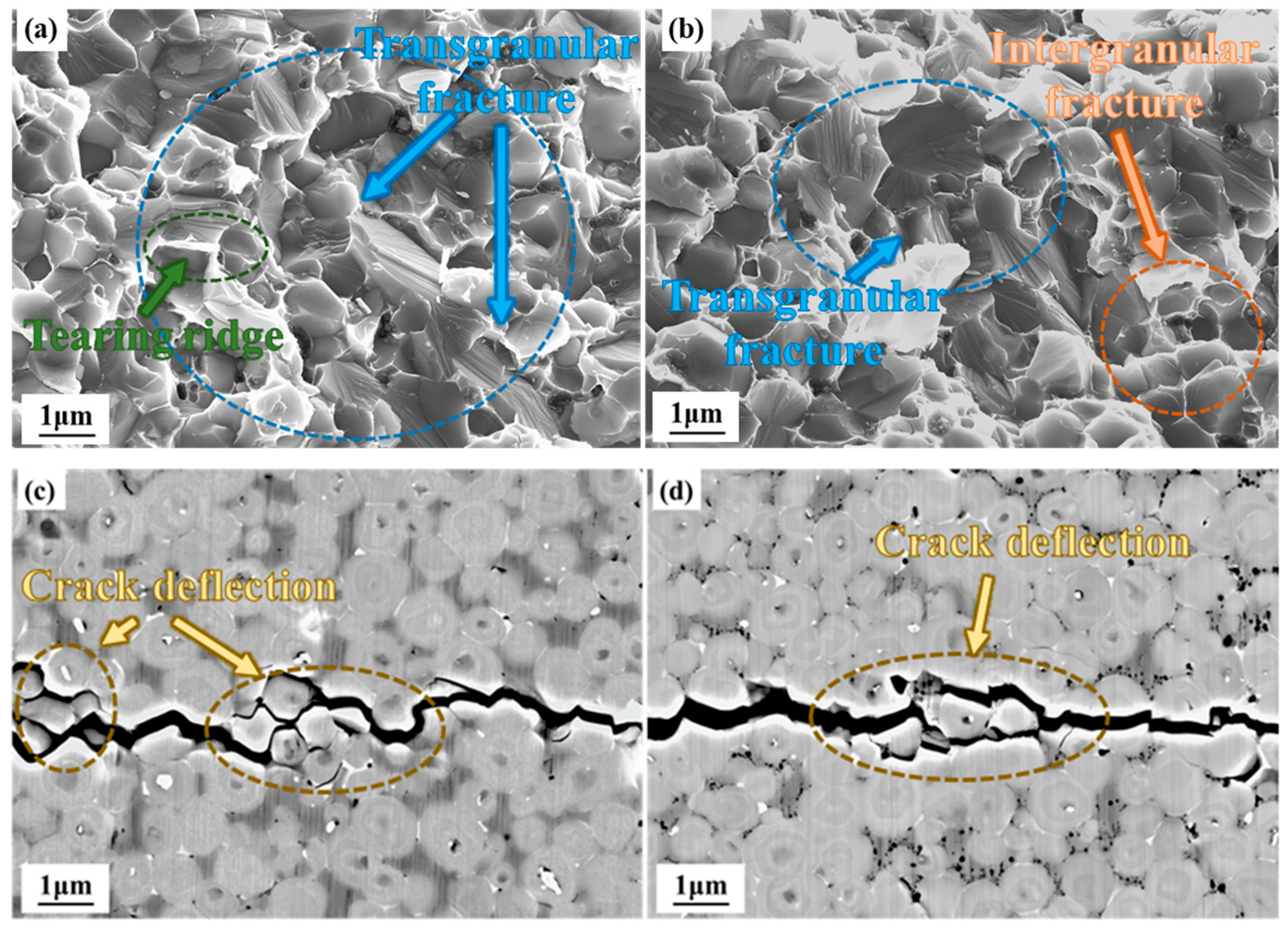Effects of Nitrogen Partial Pressure on the Microstructure and Mechanical Properties of High-Entropy Ti(C,N)-Based Gradient Cermets
Abstract
1. Introduction
2. Materials and Methods
2.1. Synthesis of High-Entropy and Non-High-Entropy Hard Phase Precursors
2.2. Ball Milling and Mixing
2.3. Gradient Structure Sintering and Nitrogen Partial Pressure Control
2.4. Structural and Mechanical Characterization Methods
3. Results
3.1. Phase Composition
3.2. Microstructure
3.3. Mechanical Properties
4. Discussion
4.1. Phase Transformation and Gradient Structure Formation
4.2. Mechanical Property Analysis
5. Conclusions
Author Contributions
Funding
Data Availability Statement
Conflicts of Interest
Abbreviations
| HE-TiCN | High-entropy gradient Ti(C,N)-based cermets. |
| C-TiCN | Non-high-entropy Ti(C,N)-based cermets. |
| HECN | High-entropy composition (Ti0.6,W0.1,Mo0.1,Nb0.1,Ta0.1)(C0.78,N0.22). |
| CCN | Non-high-entropy composition (Ti0.83,W0.07,Mo0.04,Nb0.03,Ta0.04)(C0.78,N0.22). |
| XRD | X-ray diffraction. |
| FESEM | Field Emission Scanning Electron Microscope. |
| EDS | Energy-dispersive X-ray spectroscopy. |
References
- Gavalda-Diaz, O.; Saiz, E.; Chevalier, J.; Bouville, F. Toughening of ceramics and ceramic composites through microstructure engineering: A review. Int. Mater. Rev. 2025, 70, 54–63. [Google Scholar] [CrossRef]
- Divilov, S.; Eckert, H.; Hicks, D.; Oses, C.; Toher, C.; Friedrich, R.; Esters, M.; Mehl, M.J.; Zettel, A.C.; Lederer, Y.; et al. Disordered enthalpy–entropy descriptor for high-entropy ceramics discovery. Nature 2024, 625, 66–73. [Google Scholar] [CrossRef]
- Zheng, Y.; Wang, S.; You, M.; Tan, H.; Xiong, W. Fabrication of nanocomposite Ti(C,N)-based cermet by spark plasma sintering. Mater. Chem. Phys. 2005, 92, 64–70. [Google Scholar] [CrossRef]
- Lengauer, W.; Scagnetto, F. Ti(C,N)-based cermets: Critical review of achievements and recent developments. Solid State Phenom. 2018, 274, 53–100. [Google Scholar] [CrossRef]
- Chu, S.; Liu, G.; Xiong, H.; Li, Z.; Zhou, K. High-quality Ti(C,N)-based cermets via solid-state nitrogen-pressure sintering: Influence of the sintering atmosphere. Int. J. Refract. Met. Hard Mater. 2020, 92, 105291. [Google Scholar] [CrossRef]
- Cardinal, S.; Malchere, A.; Garnier, V.; Fantozzi, G. Microstructure and mechanical properties of TiC-TiN based cermets for tools application. Int. J. Refract. Met. Hard Mater. 2009, 27, 521–527. [Google Scholar] [CrossRef]
- Zhu, X.L.; Ding, Y.X.; Li, Q.; Yi, M.D.; Zhang, J.J.; Xiao, G.C.; Chen, Z.Q.; Xu, C.H. Synthesis and cutting performance of Al2O3@ Ni-reinforced Ti(C,N) cermet by spark plasma sintering. J. Mater. Sci. 2024, 59, 18009–18027. [Google Scholar] [CrossRef]
- Hu, S.; Song, J.; Gao, J.; Liu, J.; Meng, W.; Wang, Y. Effect of layer thickness ratio on microstructure and mechanical properties of TiCN-HfN/TiCN-WC laminated ceramics. Ceram. Int. 2023, 49, 20763–20771. [Google Scholar] [CrossRef]
- Gao, J.J.; Ping, P.; Liu, J.B.; Song, J.P. Effect of Content on Microstructure and Mechanical Properties of TiCN-WC-HfN Ceramics. Powder Metall. Technol. 2024, 42, 53–58. [Google Scholar]
- Yeh, J.-W.; Chen, S.-K.; Lin, S.-J.; Gan, J.-Y.; Chin, T.-S.; Shun, T.-T.; Tsau, C.-H.; Chang, S.-Y. Nanostructured high-entropy alloys with multiple principal elements: Novel alloy design concepts and outcomes. Adv. Eng. Mater. 2004, 6, 299–303. [Google Scholar] [CrossRef]
- Cantor, B.; Chang, I.T.H.; Knight, P.; Vincent, A.J.B. Microstructural development in equiatomic multicomponent alloys. Mater. Sci. Eng. A 2004, 375, 213–218. [Google Scholar] [CrossRef]
- Yeh, J.W. Alloy design strategies and future trends in high-entropy alloys. JOM 2013, 65, 1759–1771. [Google Scholar] [CrossRef]
- Wang, Z.; Xiong, J.; Guo, Z.; Yang, T.; Liu, J.; Chai, B. The microstructure and properties of novel Ti(C,N)-based cermets with multi-component CoCrFeNiCu high-entropy alloy binders. Mater. Sci. Eng. A 2019, 766, 138345. [Google Scholar] [CrossRef]
- Fang, Y.; Chen, N.; Du, G.; Zhang, M.; Zhao, X.; Cheng, H.; Wu, J. High-temperature oxidation resistance, mechanical and wear resistance properties of Ti(C,N)-based cermets with Al0.3CoCrFeNi high-entropy alloy as a metal binder. J. Alloys Compd. 2020, 815, 152486. [Google Scholar] [CrossRef]
- Zhou, J.; Zhang, J.; Zhang, F.; Niu, B.; Lei, L.; Wang, W. High-entropy carbide: A novel class of multicomponent ceramics. Ceram. Int. 2018, 44, 22014–22018. [Google Scholar] [CrossRef]
- Zhao, Y.; Zheng, Y.; Zhou, W.; Zhang, J.; Zhang, G.; Xiong, W. Microstructure and performance of functionally gradient Ti(C,N)-based cermets fabricated by low-pressure carburizing treatment during liquid phase sintering. Ceram. Int. 2017, 43, 1956–1962. [Google Scholar] [CrossRef]
- Liu, Y.P.; Yu, H.Z.; Liu, W.J.; Cao, P. Effect of N2 partial pressure sintering time on microstructure and mechanical properties of ultrafine grained Ti(C,N) based cermets. Cem. Carbide 2024, 41, 37–42. [Google Scholar]
- Lv, J.; Du, Y.; Peng, Y.; Zhang, C.; Long, J.; Zhang, W. Effect of C content on the surface gradient structure of (Ti, Mo)(C,N) and Ti(C,N)-based cermets. J. Mater. Res. Technol. 2022, 16, 544–554. [Google Scholar] [CrossRef]
- Chen, C.; Zhang, H.; Qiao, D.; Xia, P.; Tao, X.; Dang, W.; Gu, S.; Yang, Y. Synthesis, microstructure, and properties of novel series of (Ti,W,Mo,Nb,Ta)(C0.78,N0.22) high entropy ceramic-based cermets. Ceram. Int. 2024, 50, 5570–5578. [Google Scholar] [CrossRef]
- Chen, C.; Zhang, H.; Qiao, D.; Xia, P.; Zhang, Y.; Dang, W.; Yang, Y. Microstructure and mechanical properties of (Ti,W,Mo,Nb,Ta)(C0.78,N0.22) high entropy cermets with 5-25 wt.% Co-Ni binders. Ceram. Int. 2024, 50, 42444–42452. [Google Scholar] [CrossRef]
- Sun, Y.; Dai, S. Synthesis of high-entropy materials. Nat. Synth. 2024, 3, 1457–1470. [Google Scholar] [CrossRef]
- Miracle, D.B.; Senkov, O.N. A critical review of high entropy alloys and related concepts. Acta Mater. 2017, 122, 448–511. [Google Scholar] [CrossRef]
- Peng, Y.; Miao, H.; Peng, Z. Development of TiCN-based cermets: Mechanical properties and wear mechanism. Int. J. Refract. Met. Hard Mater. 2013, 39, 78–89. [Google Scholar] [CrossRef]
- Li, Z.; Chen, L.; Chang, F.; Hong, C.; Zhao, X.; Fang, Y.; Dai, P. Synthesis, microstructure and properties of Ti(C,N)-(HfZrTaNbTi)C5-HEA high-entropy cermets by high-energy ball milling and spark plasma sintering. Ceram. Int. 2022, 48, 30826–30837. [Google Scholar] [CrossRef]
- Khan, M.A.; Nazir, Z.; Hamza, M.; Afifi, M.A. Thermodynamic, phase diagram, and high-entropy alloys system: Basic concepts. In High-Entropy Alloys; Elsevier: Amsterdam, The Netherlands, 2024; pp. 7–29. [Google Scholar]
- Vedel, D.V.; Mazur, P.V.; Grigoriev, O.M.; Melakh, L.M.; Bega, M.D.; Kozak, I.V. Preparation and mechanical properties of high-entropy ceramics (TiZrHfNbTa)C. J. Superhard Mater. 2022, 44, 323–330. [Google Scholar] [CrossRef]
- Chen, Q.; Li, A.; Wu, G.; Wang, Y. Tribochemistry of TiN films sliding against ceramic counterparts in vacuum condition and N2 atmosphere. Ceram. Int. 2022, 49, 8907–8915. [Google Scholar] [CrossRef]
- Wu, X.-T.; Azhati, L.; Xia, C.-H.; Lu, X.-G. Study on diffusion and Kirkendall effect in diffusion triples for fcc Ni-Al-Ta alloys. Calphad 2023, 82, 102566. [Google Scholar] [CrossRef]
- Li, X.-Z.; Feng, H.; Li, H.-B.; Zhang, S.-C.; Zhu, H.-C.; Yang, S.-X.; Pak, J.-J.; Jiang, Z.-H. Thermodynamic Study on Nitrogen Solubility and TiN Formation in Molten Ni-Ti-N Alloys. Metall. Mater. Trans. B 2024, 55, 3653–3662. [Google Scholar] [CrossRef]
- Cao, H.; Yang, J.; Li, Y.; Ren, L.; Qi, F.; Zhao, N.; Ouyang, X. Effect of nitrogen pressure on the microstructure, mechanical and electrochemical properties of CrAlN coatings deposited by filter cathode vacuum arc. Ceram. Int. 2022, 48, 36570–36584. [Google Scholar] [CrossRef]
- Xia, A.; Dedoncker, R.; Glushko, O.; Cordill, M.J.; Depla, D.; Franz, R. Influence of the nitrogen content on the structure and properties of MoNbTaVW high entropy alloy thin films. J. Alloys Compd. 2021, 850, 156740. [Google Scholar] [CrossRef]
- Li, M.; Yu, R.; Deng, T.; Huang, Y.; Qiu, F.; Xu, F.; Liang, B.; Xie, X.; Wang, Z.; Zhong, Z.; et al. Microstructures and properties of a novel cemented carbide prepared using a Co-Ni-Cu multiprincipal element alloy as the binder. J. Alloys Compd. 2024, 1008, 176868. [Google Scholar] [CrossRef]
- Wang, J.; Liu, Y.; Ye, J.; Ma, S.; Pang, J. The fabrication of multi-core structure cermets based on (Ti,W,Ta)CN and TiCN solid-solution powders. Int. J. Refract. Met. Hard Mater. 2017, 64, 294–300. [Google Scholar] [CrossRef]
- Ritchie, R.O. The conflicts between strength and toughness. Nat. Mater. 2011, 10, 817–822. [Google Scholar] [CrossRef] [PubMed]








| Number | Elemental Ratio | Raw Materials (wt.%) | |||||
|---|---|---|---|---|---|---|---|
| C | TiO2 | WO3 | Nb2O5 | Ta2O5 | MoO3 | ||
| HECN | (Ti0.6,W0.1,Mo0.1,Nb0.1,Ta0.1)(C0.78,N0.22) | 23.42 | 30.36 | 14.69 | 8.42 | 14.00 | 9.12 |
| CCN | (Ti0.83,W0.07,Mo0.04,Nb0.03,Ta0.04)(C0.78,N0.22) | 25 | 50 | 12 | 4 | 4 | 5 |
| Pressure/kPa | 2θ (200)/° (HE) | 2θ (200)/° (C) | a/Å (HE) | a/Å (C) |
|---|---|---|---|---|
| 1 | 41.36 | 41.26 | 4.362 | 4.373 |
| 2 | 41.5 | 41.3 | 4.348 | 4.369 |
| 4 | 41.58 | 41.52 | 4.341 | 4.346 |
| 6 | 41.62 | 41.7 | 4.336 | 4.328 |
| 8 | 41.7 | 41.73 | 4.328 | 4.325 |
Disclaimer/Publisher’s Note: The statements, opinions and data contained in all publications are solely those of the individual author(s) and contributor(s) and not of MDPI and/or the editor(s). MDPI and/or the editor(s) disclaim responsibility for any injury to people or property resulting from any ideas, methods, instructions or products referred to in the content. |
© 2025 by the authors. Licensee MDPI, Basel, Switzerland. This article is an open access article distributed under the terms and conditions of the Creative Commons Attribution (CC BY) license (https://creativecommons.org/licenses/by/4.0/).
Share and Cite
Zhang, Y.; Zhang, H.; Qiao, D.; Tao, X.; Xia, P.; Gu, S. Effects of Nitrogen Partial Pressure on the Microstructure and Mechanical Properties of High-Entropy Ti(C,N)-Based Gradient Cermets. Crystals 2025, 15, 479. https://doi.org/10.3390/cryst15050479
Zhang Y, Zhang H, Qiao D, Tao X, Xia P, Gu S. Effects of Nitrogen Partial Pressure on the Microstructure and Mechanical Properties of High-Entropy Ti(C,N)-Based Gradient Cermets. Crystals. 2025; 15(5):479. https://doi.org/10.3390/cryst15050479
Chicago/Turabian StyleZhang, Yunhao, Houan Zhang, Dongxu Qiao, Xin Tao, Peng Xia, and Siyong Gu. 2025. "Effects of Nitrogen Partial Pressure on the Microstructure and Mechanical Properties of High-Entropy Ti(C,N)-Based Gradient Cermets" Crystals 15, no. 5: 479. https://doi.org/10.3390/cryst15050479
APA StyleZhang, Y., Zhang, H., Qiao, D., Tao, X., Xia, P., & Gu, S. (2025). Effects of Nitrogen Partial Pressure on the Microstructure and Mechanical Properties of High-Entropy Ti(C,N)-Based Gradient Cermets. Crystals, 15(5), 479. https://doi.org/10.3390/cryst15050479






